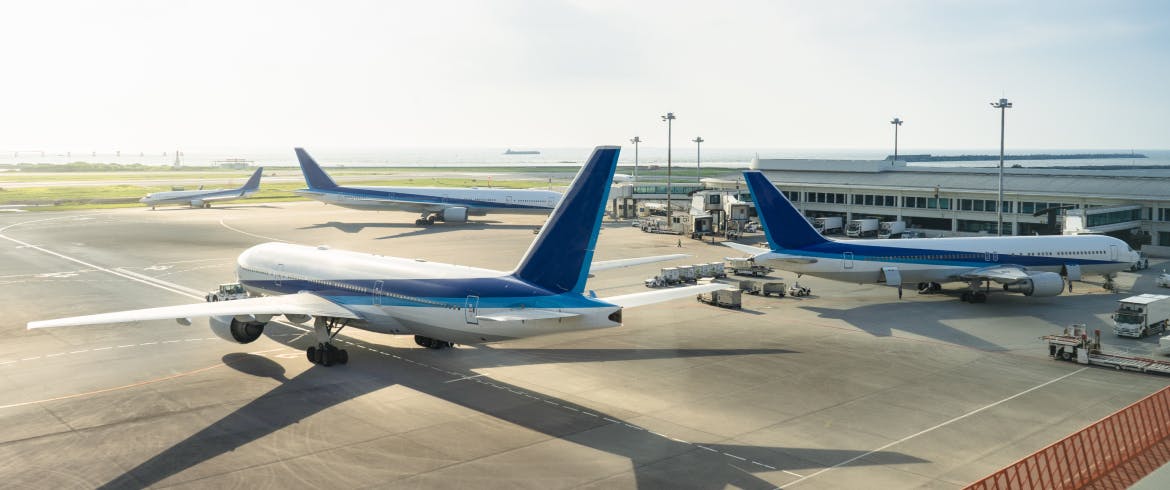
Data Insights - How to Maximise Procurement Efficiency At Scale
By Jevgeni Rogotski, Product Manager at SkySelect
In aviation, purchasing volumes can grow exponentially, and buying one part at a time while
trying to find the best price quickly becomes unmanageable. This is especially true with many organizations facing a resource crunch. This is precisely the challenge that airlines and MROs face in their day-to-day operations.
There are three solutions to eliminate sourcing:

To learn more about the specifics of these three approaches, we recommend reading our previous article: Do Contracts & Catalogs Deliver on the Promise of OTP & Cost Savings?
Eliminating sourcing using the traditional approach - Contracts
Firstly, not all the parts can be included in the contract (exclusive, non-exclusive, catalogues, etc.), especially for unplanned purchases. Typically, we see that 20-30% of the parts are on contract. The highest we have seen is 80%.
However, if we look at it from the order follow-up perspective and consider order changes (ship by date, price, qty, PN), then our data shows that 34% of contract-based POs will have changes.
So if you are placing 100,000 POs in a year and 80% are placed on contracts, then on a high level, it can look good that 80% of the work is automated. However, in the follow-up, 34% of the POs may have changed. So the math is simple: 80,000 POs are placed based on contracts, and around 27,000 POs will have changes.

The chances that a PO changes significantly when buying parts on the live market with automation are low. (Data Source: SkySelect.com)
Let's consider this from a different perspective. The graph below illustrates how the probability of changes occurring in the order stage varies depending on the buyer’s decision time to place a purchase order after receiving a quote.

The longer the time between the PO and receipt of a quote, the greater the chances that a change to the PO occurs. The chances are consistently greater with contracts. (Data Source: SkySelect.com)
In the first days, the probability is significantly lower for the live market as the quotes reflect actual stock levels and prices. However, as time progresses, the reliability of quote information deteriorates, gradually approaching the contract-based levels. However, it is interesting to note that even after 2+ weeks the live market quotes are still more accurate compared to contracts.
Eliminating sourcing using the new approach - Parts Procurement AI
AI can achieve a similar success rate of automating 80-90% of purchases. However, the key difference is that purchase orders are now generated based on real-time market availability rather than static contracts.
If we look from the order follow-up perspective, then depending on how fast the decisions are made, only between 5% to 25% of the POs may require changes.
Let’s use the same number of 100,000 POs and consider that 80% is automated by AI. Assuming 11% will need changes, it translates to less than 9,000 POs requiring adjustments. Without considering other factors like cost savings, this difference alone could result in 18,000 fewer POs needing manual intervention.
Static Contracts Often Fall Short in Dynamic Aviation Market
To scale procurement operations, especially when faced with limited labour resources, airlines and MROs have traditionally relied on exclusive and non-exclusive contracts to automate the placement of purchase orders (POs).
At first glance, this approach seems effective—negotiating long-term contracts for routine maintenance parts allows companies to streamline procurement while manually sourcing and placing POs for any remaining needs. The idea is simple: "Set it and forget it," enabling scalability while reducing the cognitive burden on buyers.
However, the aviation industry’s dynamic nature exposes the limitations of this strategy.
Contracts and catalogue-based sourcing are often rigid, locking companies into predetermined terms that don't adapt well to unexpected changes. These arrangements typically come at a higher cost, as suppliers charge premiums of 5-20% above market rates to mitigate risk. Over time, these long-term contracts can become less favourable for buyers, failing to keep up with shifts in the market.
Additionally, a substantial number of POs will fail completely or face significant delays due to a lack of market availability. This results in a cascade of inefficiencies, leading to missed deadlines, operational delays, and increased costs. Furthermore, buyers are burdened with the extra workload of amending POs, compounding the problem.
The reliance on rigid contracts and POs can, therefore, lead to poor on-time performance (OTP), missed savings, and operational disruptions. For procurement teams where precision, timing, and efficiency are critical, these issues are not just minor setbacks—they can significantly impact overall performance and profitability.
Artificial Intelligence: The Fully Automated Solution
Fortunately, there’s a better way to (fully) automate, and that’s with artificial intelligence (AI) procurement automation platforms such as SkySelect. By leveraging AI, airlines and MROs can address the root causes of these inefficiencies rather than just treating the symptoms. AI doesn’t just automate the placement of orders; it fundamentally changes the way parts are procured.
The power of AI lies in its ability to check availability across multiple suppliers in real-time with consideration of your business rules before placing an order. The technology can automatically check the real-time availability of parts from your preferred vendors and the broader market without any manual effort or added work needed from buyers.
This ensures that orders are only placed when parts are actually available, dramatically reducing the likelihood of bounced POs and adding a whole new layer of risk mitigation.
AI can also identify the best option automatically, considering the price, logistics costs, and delivery times, all without requiring manual intervention of comparing quotes.
90-95% of aircraft parts purchases are below $5,000 and account for about 30% of the total spend. These smaller purchases are often seen as low priority, but they present a massive opportunity for automation. By applying AI to these routine transactions, companies can streamline their procurement processes, freeing up valuable resources to focus on more strategic initiatives.
This level of automation isn’t just about reducing workload; it’s about transforming the procurement process from a reactive, manual task to a proactive, strategic function that can assess risks before they happen and ensure the optimal outcome.
Airlines and MROs that embrace AI-powered procurement see a significant reduction in bounced PO and stock-outs, leading to better on-time performance, reduced costs, and, ultimately, a stronger bottom line.
Summary: AI is the Catalyst for True Automation
While manual sourcing might work on a small scale, it’s unsustainable as businesses grow and demands increase. With its unique challenges, the aviation industry requires more than just traditional automation strategies — it needs the precision and adaptability that only AI can offer today.
By eliminating manual sourcing and embracing AI-powered automation, airlines and MROs can secure the best prices at scale, ensuring that their procurement processes are not only efficient but also resilient in the face of uncertainty. In an industry where every dollar and minute counts, AI offers a path to smarter, more efficient procurement at scale.

Sourcing across broad market supplier participants yields better on-time performance and savings metrics. Contact us now and get started with transactional purchasing!
